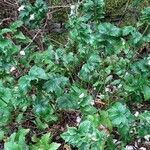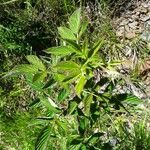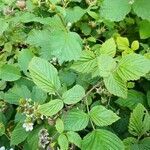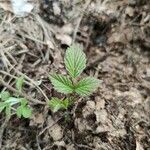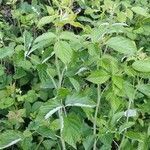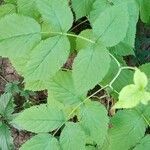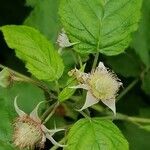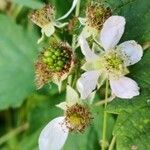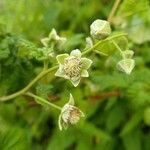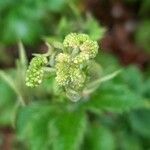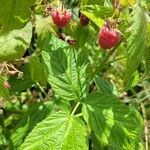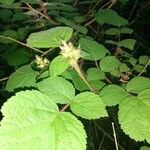Shrubs, 5–25 dm, armed or unarmed. Stems ?biennial?, erect, glabrescent, eglandular or stipitate-glandular, strongly pruinose; prickles absent or sparse to dense, erect, weak, 1–4 mm, broad-based; ?bristles present or absent?. Leaves deciduous, pinnately compound; stipules filiform, 5–10 mm; ?petiole unarmed or with prickles, strigose or glabrous, glandular or eglandular; terminal leaflets petiolulate, lateral sessile or subsessile?; leaflets 3–5(–7), terminal ovate to lanceolate, 7–15 × 4–11 cm, base rounded to cordate, unlobed or 2-lobed, margins serrate to doubly serrate, apex acute to attenuate, abaxial surfaces unarmed or with prickles, strongly white-tomentose, eglandular or glandular. Inflorescences terminal and axillary, (1–)3–7(–20)-flowered, racemiform. Pedicels unarmed or prickles sparse, hooked, glabrous or sparsely pubescent, stipitate-glandular or eglandular. Flowers bisexual; petals white to greenish white, spatulate to obovate, 5–10 mm; filaments filiform or slightly dilated basally; ovaries pubescent. Fruits usually red to whitish, rarely amber, globose to conic, 0.5–2 cm; drupelets 10–60, coherent, separating from torus.
Stems to 2 m, erect, spreading, or decumbent, sparsely to densely armed with slender-based prickles and stiff, glandular bristles; primocane lfls 3 or 5, ovate to lanceolate, acuminate, sharply serrate mostly above the middle, softly gray-pubescent beneath; intermediate pair of lfls, when present, inserted close to the terminal lfl; infl an umbelliform cyme of 2–5 fls, often also with 1 or 2 solitary fls from the upper axils; pedicels stipitate-glandular and ± bristly, the bristles exceeding the glandular hairs and gland-tipped when young; sep soon reflexed; pet white or greenish-white, spatulate to obovate, erect, shorter than the sep; fr red (yellow), 1–1.5 cm thick, separating as a unit from the persistent receptacle; 2n=14, seldom more. Dry or moist woods, fields, and roadsides; Nf. to Alas., s. to Pa., Ind., Io., and Ariz. May–July. The Amer. and e. Asian plants, as here described, constitute the var. strigosus (Michx.) Maxim., in contrast to the eglandular Eurasian var. idaeus, which is cult. in many cultivars. At the subspecific level our plants would be subsp. melanolasius Focke. (R. strigosus)
Suckering, erect shrub, up to 1.5-(3) m high; stems erect when young, sometimes almost decumbent when older, terete, sparsely to densely hairy when young, soon becoming glabrous, somewhat pruinose, suckering by adventitious buds; armature of weak, ± terete, erect prickles, these often very numerous (rarely almost 0) on young stems and sometimes sparse on older stems. Lvs usually imparipinnate with 2-(3) pairs of leaflets, rarely pinnately 3-foliolate, rugose, glabrescent, sometimes with whitish bloom on upper surface, densely white-tomentose on lower surface, 1-2-serrate; terminal leaflet ovate to ovate-oblong, sometimes slightly lobed, up to 115 × 85 mm, acuminate, truncate to cordate at base, petiolulate; stipules linear. Infl. a few-flowered leafy raceme; axis and branches pilose and prickly. Fls 20-25 mm diam. Sepals long-triangular, acuminate, tomentose, paler on margins, deflexed at fruiting. Petals narrow, flat, white. Stamen filaments white. Fr. of waxy, red or orange drupelets, cylindric, up to 15 mm long.
A small cane-like shrub. It grows 1.5-2 m tall. The branches are red or brown. They have a few prickles. The leaves are often divided into 5-7 leaflets. The flowers are white. They can be in the axils of leaves or at the ends of branches. The fruit are red or orange and half round. They are 1-1.4 cm across. There are many named varieties.
